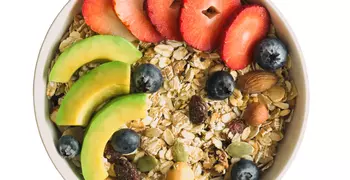Food As Medicine

How Should I Start?
 A group of 10-year-old girl scouts was asked, "What makes up a healthy diet and lifestyle?" Their answer was simple: Eat fruits, vegetables, and whole grains; drink water; don't eat candy; and play.
A group of 10-year-old girl scouts was asked, "What makes up a healthy diet and lifestyle?" Their answer was simple: Eat fruits, vegetables, and whole grains; drink water; don't eat candy; and play.
Marion Nestle, a New York University nutritionist, agrees with the girls. Her recommendations: "Eat less, move more; consume plenty of fruit, vegetables and whole grains; and avoid too much junk food."
In his 2008 book, In Defense of Food, Michael Pollan's recommendation is also simple.
"Eat food. Not too much. Mostly plants."
Why don't we eat a healthy diet?
If eating a healthy diet is as simple as Pollan says, why are there so many people who don't do it? We outline two important factors below.
We focus on foods to avoid
During the past three decades, the focus has been on good food versus bad food, with the primary focus on avoiding the "bad."
But what qualified as bad kept changing. Fats were the enemy for years. Then carbohydrates joined the ranks of bad foods. Animal protein became bad and plant protein good. Of course calories were always on everyone's mind.
While we focused on identifying enemy foods, we forgot to discuss what foods we should eat. As nutrition research is beginning to show, what we fail to eat may impact our health more than eating "bad" foods.
We know but don't act
We are all well aware of the simple mantra...fruits, vegetables, whole grains; fruits, vegetables, whole grains. We are intelligent and well informed. However there is often a gap between our knowledge of what to do and our actually doing it.
Despite a national fruit and vegetable campaign in 1991, a John's Hopkins study found that American fruit and vegetable consumption has not increased. Only about 10 percent ate the recommended "five a day" of fruits and vegetables and at least 50 percent did not eat any vegetables! Keep in mind, the people surveyed considered themselves nutrition "savvy" (American Journal of Preventive Medicine, 2007).
What can we do to overcome these barriers?
One way to address both of these factors is to think about food as information. This prompts us to ask:
- What signals is this food sending my body?
- Will this food create and support health or contribute to the development of dysfunction, symptoms, and disease?
Asking these questions can help you choose foods to include and motivate you to close the action gap!
Start with one key rule of thumb: Include foods that are natural and whole while excluding those that have been "monkeyed with."
1. Eat a variety of foods.
 What are the top 10 things I should do?Studies show that people who eat a variety of food are healthier, live longer, and have a reduced risk of diseases, such as heart disease, cancer, and diabetes.
What are the top 10 things I should do?Studies show that people who eat a variety of food are healthier, live longer, and have a reduced risk of diseases, such as heart disease, cancer, and diabetes.
Food variety means including foods such as fruit, vegetables, whole grains, legumes, meat, fish, seafood, nuts and seeds, and dairy products. Variety also means including an array of foods within each of these categories. For instance whole grains can be whole wheat, wild rice, oats, rye, or barley.
Because certain nutrients are present in particular foods, eating a variety of different foods allows you to get a variety of nutrients. Variety means that you will include protein, fats, carbohydrates, vitamins and minerals, phytonutrients, and fiber in your diet. The U.S. Department of Agriculture has recently launched a visual graphic to help you make healthy dietary choices at Choose My Plate. This graphic has replaced the traditional food pyramid and recommends dividing your plate into four quadrants, with fruits and vegetables taking up half the plate. Proteins and grains should take up the other half.
By eating a diet that includes a variety of foods, you will be providing the nutrients that are involved in functions such as hormone synthesis (which influences your mood) or boosting your immune system.
2. Increase fruits and vegetables.
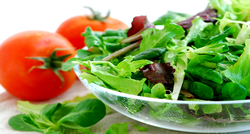 Scientific data on the benefits of fruits and vegetables in preventing a variety of diseases has been mounting. For example, several studies show that the higher the consumption of fruit and vegetables, the lower the incidence of cardiovascular disease, including stroke (American Journal of Clinical Nutrition, 2008).
Scientific data on the benefits of fruits and vegetables in preventing a variety of diseases has been mounting. For example, several studies show that the higher the consumption of fruit and vegetables, the lower the incidence of cardiovascular disease, including stroke (American Journal of Clinical Nutrition, 2008).
The 2005 Dietary Guidelines for Americans from the USDA Center for Nutrition Policy and Promotion recommends five to thirteen servings of fruits and vegetables a day, depending on caloric intake. A serving is one piece of fruit, ½ cup of vegetable, 1 cup of salad greens, or ½ cup of juice.
Fruits and vegetables are not only full of vitamins and minerals, but they contain beneficial phytonutrients. A plant cannot flee or fight so it is equipped with "phyto," or plant, nutrients that can defend against disease, blight, radiation, weather, insects, and anything that may threaten its survival. When we eat these plants, we also benefit from the protection of the phytonutrients. Phytonutrient content is indicated by the color of the food. To get a variety of phytonutrients, aim for a minimum of five colors a day.
Fruits and vegetables also influence gut flora (good bacteria) and contain fiber to assist in the performance of the gastrointestinal system. Fruits and vegetables slow carbohydrate absorption and are generally low in calories. They also give us a feeling of fullness, and we eat less.
What about fresh versus frozen?
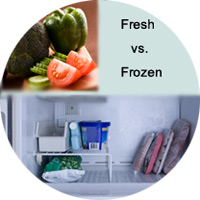 Fruits and vegetables processed for freezing tend to be flash-frozen at their peak ripeness and nutrient density. Freezing locks in plant nutrients.
Fruits and vegetables processed for freezing tend to be flash-frozen at their peak ripeness and nutrient density. Freezing locks in plant nutrients.
Fresh fruits and vegetables that are shipped to other states are generally picked before they are ripe, which gives them less time to develop optimal levels of vitamins, minerals, and phytonutrients. In addition, fruits and vegetables begin to lose nutrients moments after they are picked. Shipping and storage can also negatively impact nutrient content due to variables such as temperature, distance for shipping, and handling procedures, according to the USDA Agricultural Research Service Center.
The solution is to buy locally grown fruits and vegetables that have traveled the least amount of distance to the table whenever possible and supplement that with frozen products.
3. Choose whole grains.
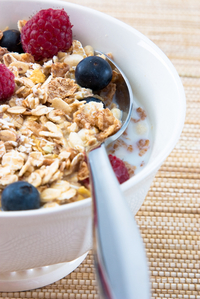 Data from the now famous Nurse's Health Study shows whole grains reduce the risk of diabetes and heart disease and improve the health of the gastrointestinal tract. Whole grains contain multiple nutrients. But when whole grain is processed, the following amounts of nutrient content, or "information," is lost:
Data from the now famous Nurse's Health Study shows whole grains reduce the risk of diabetes and heart disease and improve the health of the gastrointestinal tract. Whole grains contain multiple nutrients. But when whole grain is processed, the following amounts of nutrient content, or "information," is lost:
- 60% of calcium
- 85% of magnesium
- 77% of potassium
- 78% of zinc
- 75% of vitamins
- 95% of fatty acids
- 95% of fiber
Because the nutrient content is essentially stripped during processing, manufacturers then fortify the food with nutrients such as B-vitamins. Unfortunately fortification cannot possibly compensate for all of the active components in grain. One extremely important component that is left out is fiber. (There are undoubtedly other important components left out that haven't been identified yet.)
Fiber makes us feel full faster and longer; therefore, it may prevent overeating. Fiber also plays an important role in the digestive system, allowing nutrients to be more fully absorbed and slowing the rise in blood sugar glucose, as well as aiding in the elimination of waste.
4. Include beneficial fats.
 For years, fat was deemed to be public enemy #1. Even today many Americans view fat as something to avoid in their diets. But, as we learn more about the effects of fats in the body, the message has become that fat, in and of itself, is not the issue. After all, fat is a vital nutrient.
For years, fat was deemed to be public enemy #1. Even today many Americans view fat as something to avoid in their diets. But, as we learn more about the effects of fats in the body, the message has become that fat, in and of itself, is not the issue. After all, fat is a vital nutrient.
The issue is the type and quality of fat that is predominant in the Standard American Diet.
Our bodies need a balance of two types of fatty acids: omega 3 and omega 6, but we tend to get too much omega 6.
Omega 6: Animal fats, butter fats, and corn oil contain a predominance of omega 6 fatty acids and tend to produce inflammation in the body.
Omega 3: Plant oils, such as avocado, olive oil, canola oil, flaxseed oil, oils from nuts and seeds, and fats from fish whose diet is made up of algae contain a predominance of omega 3 fatty acids and have an anti-inflammatory effect on the body.
Inflammation is essential to the body's ability to maintain immunity and protection, but too much inflammation can cause injury. It is important that the body maintain a balance of pro-inflammatory messages and anti-inflammatory messages.
Mounting evidence suggests that eating beneficial fats helps maintain this balance. The Standard American Diet tends to be deficient in anti-inflammatory fats and excessive in pro-inflammatory fats. Widespread use of corn oil and consumption of grain-fed beef, rather than grass-fed beef (also containing omega 3 fatty acids) has potentially contributed to pro-inflammatory health issues.
In his book Eating Well for Optimal Health, Dr. Andrew Weil suggests "it is more than possible that the epidemic of coronary heart disease and fatal heart attacks that took place in the 20th century correlates not so much to excesses in what people were consuming, but rather with the deficiencies of protective factors that in the past neutralized harmful effects." Omega 3 fatty acids are an important protective factor, and deficiency is prevalent.
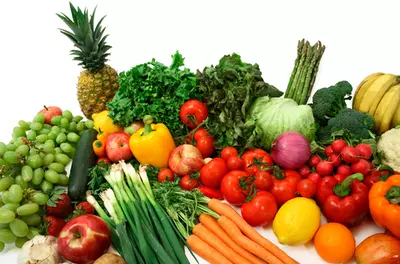
Healthy foods to have on hand for quick, easy meals
Stock the following foods in your pantry so you always have the ingredients for a quick, healthy meal on hand.
Healthy Foods to Have on Hand for Quick, Easy Meals
Stock the following foods in your pantry so you always have the ingredients for a quick, healthy meal on hand. For example, you can quickly cook some pasta and add a pesto sauce and some pine nuts or walnuts for a basic meal. Or you can cook couscous and add chickpeas, raisins, and a curry sauce. Add fresh vegetables, such as tomatoes or zucchini to the pasta, or cauliflower and shredded carrots to the couscous, for additional health and enjoyment.
- A variety of grains such as millet, buckwheat, oats, barley, brown rice, and quinoa
- Boxed rice, couscous, risotto
- Dried pastas, such rotini, penne, and spaghetti
- Canned salmon, tuna, and sardines
- Olive oil, sesame oil, canola oil, coconut oil
- Vinegars, such as balsamic and red wine vinegar
- Jarred olives, artichoke hearts, capers, sun dried tomatoes, and roasted red peppers
- Black and green olives
- Canned whole, diced, crushed, and stewed tomatoes and tomato paste
- Pumpkin seeds, sunflower seeds, and sesame seeds
- Almonds, pecans, walnuts, and pine nuts
- Dried herbs, particularly thyme, basil, and oregano
- Sea salt
- Tamari, salsa, and other bottled sauces, such as an apricot chipotle, pesto, curry or Asian sauce
- Canned beans, such as cannelloni, black, pinto, chickpeas, or great northern
- Cartons and cans of soup
- Cartons and cans of vegetable and chicken broth and stock
- Canned pineapple, jarred applesauce, preserves, and jams
- Coconut and other dried fruit, such as apricots, plums, and golden raisins
- Honey or agave

Sample Mediterranean menu
Check out these healthy meal ideas that focus on whole, natural foods that are low in trans-fatty acids.
Sample Mediterranean Menu
Breakfast
- Whole grain bread (toasted)
- Almond butter
- Apple slices
- Goat cheese
Lunch
- Roasted Red Pepper and Tomato Soup (Pacific Foods brand, as an example)
- Pre-made humus, whole grain crackers and baby carrots
- Yogurt spooned over cut up grapes and strawberries
Mid-Afternoon Snack
- Dried apricots
- Walnuts
Dinner
- Halibut sautéed in olive oil with lemon and thyme
- Boxed couscous with added diced tomatoes, parsley, and chickpeas
- Asparagus drizzled with olive oil sprinkled with pepper
- Mixed greens salad with olives (green or black), cucumbers, tomatoes, and parmesan cheese dressed with oil and vinegar
5. Drink water.
 When concocting a recipe for health, one of the most important ingredients is water. The body is made up of up to 65 percent water. The brain is composed of 70 percent water and the lungs are 90 percent water. A whopping 83 percent of the blood is water.
When concocting a recipe for health, one of the most important ingredients is water. The body is made up of up to 65 percent water. The brain is composed of 70 percent water and the lungs are 90 percent water. A whopping 83 percent of the blood is water.
Water is needed for the digestion, absorption, and transportation of nutrients. Water keeps skin smooth and soft, serves as a solvent for waste, reduces toxicity, and flushes toxins and excess salt from the body. It also regulates body temperature and is useful in managing hunger. Sometimes the cue for thirst is confused as a cue for food.
The loss of only 5 to 10 percent of body water can cause dehydration. (You lose water during the day when you perspire and urinate, and water is even expired through the lungs when breathing.) When dehydrated, the body is unable to cool itself. Dehydration also increases the tendency of blood to clot.
The Institute of Medicine (IOM) advises men to consume roughly 3.0 liters (about 13 cups) of water a day and women to consume 2.2 liters (about 9 cups) of water a day.
Eighty percent of this should come from drinking water and other beverages, (but not soda, coffee, or alcohol). The remaining 20 percent should come from foods - especially fruits and vegetables, which are 70 to 95 percent water.
Your water needs depend on many factors, including your health, how active you are, and where you live. It's generally not a good idea to use thirst alone as a guide for when to drink. By the time you become thirsty, you may already be slightly dehydrated. Note that as you get older, your thirst sense is diminished. It is especially important for older adults to drink water before they become thirsty.
6. Include green tea.
 The healthful properties of green tea are primarily attributed to its potent antioxidant activity and polyphenols (phytonutrinets) called catechins. The most active of these polyphenols in green tea is called epigallocatechin (also known as EGCG).
The healthful properties of green tea are primarily attributed to its potent antioxidant activity and polyphenols (phytonutrinets) called catechins. The most active of these polyphenols in green tea is called epigallocatechin (also known as EGCG).
Numerous studies have shown an association between the consumption of green tea and protection against cancer, including breast cancer, colon caner, and esophageal cancer.
Green tea and green tea extracts have also been used for improving mental alertness, aiding in weight loss, protecting skin from sun damage, and lowering cholesterol. An International Heart Journal (2007) study showed that green tea catechins decreased circulating LDL cholesterol. A 2008 study published in the American Journal of Clinical Nutrition found that the green tea increased fat burning, as well as improved insulin sensitivity and glucose control during moderate exercise.
Generally, two to three cups of green tea daily is the recommended intake for the most benefit. When steeping green tea, it is recommended that you use hot water (185 degrees) rather than boiling hot water (212 degrees). Boiling water will "cook" the tea leaves and create a bitter tasting tea. You can substitute green tea for some of the recommended water you should drink daily.
7. Control portions.
While calories are not the whole picture, it has long been shown that moderate calorie restriction is a way to slow the aging process.
A 2006 Clinical Interventions in Aging article on delaying age-related disease recommended, on the basis of current research, a diet low in calories and saturated fats and high in whole grains, legumes, and fruits and vegetables - all of which maintain lean body weight.
 Here are some strategies to avoid overeating:
Here are some strategies to avoid overeating:
- Pay attention to what, when, and why you eat. Keeping a food diary helps people lose weight.
- Discern between hunger and thirst - you might think you are hungry when you are really thirsty.
- Try to avoid eating standing up, watching TV, or driving.
- Eat slowly and chew. You will get more "food experience" from fewer calories.
- Eat smaller, more frequent meals (every three to four hours). Skipping meals or waiting too long before eating causes excessive hunger and may lead to eating larger portions at the next meal.
- Americans tend to use visual cues to tell them when they are full, such as when the plate or bowl is empty. So use smaller plates.
- Be aware of what a serving is: one serving (three ounces) of meat, poultry, or fish is about the size of a deck of playing cards. A one-cup serving of potatoes, rice, or pasta looks like a tennis ball. One serving of fruits or vegetables is about the size of a small fist. A one-ounce serving of cheese is about the size of your thumb.
8. Avoid trans-fatty acids.
Trans-fatty acids are man-made fats, created by adding hydrogen to vegetable oil in a process called hydrogenation. Hydrogenation is favored by manufacturers because it increases shelf-life and adds stability to foods.
When a trans-fat is eaten, the body recognizes it as a fat and uses the trans-fat for function just like any other fatty acid. Fats are powerful modulators of cell function, but because hydrogenation alters the chemistry of the vegetable oil, it is less effective as a fat. For instance when trans-fats are used to makes cell membranes, the membrane can become excessively permeable.
Trans-fatty acids can affect function and responses of many cell types. They have been shown to cause endothelial dysfunction, raise LDL, lower HDL, increase triglycerides, and promote inflammation (New England Journal of Medicine, 2006).
A marketplace survey published in the Journal of the American Dietetic Association (2008) showed that the food industry has made progress in reducing trans-fatty acid content in a variety of products. However researchers recommended consumers read labels carefully because the trans-fat content of individual products vary considerably. Products lower in trans-fats tend to cost more, which may be a barrier to their purchase for price-conscious consumers.
9. Avoid corn syrup and other artificial sweeteners.
The U.S. department of Agriculture reports that the consumption of high fructose corn syrup increased more than 1,000 percent between 1970 and 1990. Now evidence is mounting that corn syrup has negative impacts on health.
 For example, research reported at an August 2007 National Meeting of the American Chemical Society stated that soft drinks sweetened with high fructose corn syrup may contribute to the development of diabetes, especially in children. Additionally the researchers, from Rutgers University, found "astonishingly high" levels of reactive compounds (called carbonyls) in the soft drinks containing high fructose corn syrup. The compounds, associated with "unbound" fructose and glucose molecules, are believed to trigger cell and tissue damage. The researchers noted that by contrast, reactive carbonyls are not present in table sugar where fructose and glucose are "bound" and chemically stable.
For example, research reported at an August 2007 National Meeting of the American Chemical Society stated that soft drinks sweetened with high fructose corn syrup may contribute to the development of diabetes, especially in children. Additionally the researchers, from Rutgers University, found "astonishingly high" levels of reactive compounds (called carbonyls) in the soft drinks containing high fructose corn syrup. The compounds, associated with "unbound" fructose and glucose molecules, are believed to trigger cell and tissue damage. The researchers noted that by contrast, reactive carbonyls are not present in table sugar where fructose and glucose are "bound" and chemically stable.
A 2004 article in the American Journal of Clinical Nutrition identifies an association between the consumption of high-fructose corn syrup and the epidemic of obesity. Because the digestion, absorption, and metabolism of high fructose corn syrup differs from ordinary glucose, these researchers suggested that high fructose corn syrup may contribute to increased calorie intake and weight gain. For example, when we eat ordinary sugar, the body produces an important signaling hormone called leptin that tells the brain that the body is full and hence controls our eating. But when we eat high fructose corn syrup, we don't produce leptin and don't get a signal to stop.
It is best to avoid or limit soft drinks, including diet soda. A study published in Circulation (2008) found a 34 percent increase in risk for metabolic syndrome in subjects who consumed diet soda. (Investigators felt that weight gain over the years might contribute to some of this, but even after adjusting for demographic factors, such smoking, physical activity, and energy intake, there was still an adverse association between diet soda and metabolic syndrome.) Metabolic syndrome is a condition that can lead to diabetes and cardiovascular disease.
10. Limit processed foods.
 The Standard American Diet is severely lacking in nutrients, in large part because of the many processed foods we choose. While these processed foods lack nutrients, they often contain artificial color, additives, flavorings, and chemically altered fats and sweeteners. And while some of these processed foods claim to be low in fat, they are often high in sugar.
The Standard American Diet is severely lacking in nutrients, in large part because of the many processed foods we choose. While these processed foods lack nutrients, they often contain artificial color, additives, flavorings, and chemically altered fats and sweeteners. And while some of these processed foods claim to be low in fat, they are often high in sugar.
Michael Pollan, in his recent book In Defense of Food suggests, "if you are concerned about health, you should probably avoid products that make health claims. Because a health claim on a food product is a strong indication it's not really food, and food is what you want to eat." (And many of the claims are misleading. For example, one product proudly claims that it "contains 9 grams of whole grains." This might impress you, unless you know that a gram is about the weight of a paper clip!)
A common recommendation for healthy eating is to shop around the perimeter of the supermarket, where the fresh, natural, non-processed foods tend to be. However this is not fail safe. Sometimes additives and preservatives and corn syrup have been added to dairy products or salad dressing that would otherwise be considered natural.
Thus Michael Pollon goes a step further and recommends getting out of the supermarket whenever possible. "You won't find high-fructose corn syrup at the farmers' market. You also won't find any elaborately processed food products with long lists of unpronounceable ingredients or dubious health claims." Other options are food co-ops, natural food stores, or farm shares.
Albers, M.J., Harnack, L.J., Steffen, L.M., Jacobs, D.R. (2008). 2006 marketplace survey of transfatty acid content of margarines and butters, cookies and snack cakes and savory snacks. Journal of the American Dietetic Association, 108(2) 367-370.
American Chemical Society 234th National Meeting & Exposition (2007). August 19-23, 2007, Boston, MA.
Bray, G.A., Samara, J.N., Popkin, B.M. (2004). Consumption of high-fructose corn syrup in beverages may play a role in the epidemic of obesity. American Journal of Clinical Nutrition, 79, 537-43.
Casagrande, S.S., Wang, Y., Anderson, C., Gary, T.L. (2007). Have Americans increased their fruit and vegetables intake? The trends between 1988 and 2002. American Journal of Preventive Medicine, 32(4), 257-263.
Fusco, D., Colloca, G., lo Monaco, M.R., Cesari, M. (2006). Effects of antioxidant supplementation on the aging process. Clinical Interventions in Aging, 93(2), 377-387.
Inami, S., et al. (2007). Tea catechin consumption reduces circulating oxidized low-density lipoprotein. International Heart Journal, 48(6), 725-732.
The Institute of Medicine (IOM)
Lutsey, P.L., Steffen, L.M., Stevens, J. (2008). Dietary intake and the development of the metabolic syndrome. Circulation. Doi:10.1161.
Mozaffarian, D., et al. (2006). New England Journal of Medicine, 354(15), 1601-1613.
Padayatty, S.J., Levine, M. (2008). Fruits and vegetables: think variety, go ahead, eat. American Journal of Clinical Nutrition, 78(1): 5-7.
The 2005 Dietary Guidelines for Americans from the USDA Center for Nutrition Policy and Promotion.
University of Minnesota Extension Service Nutrition Education Programs
U.S. Department of Agriculture (USDA) Agricultural Research Service Center.
Venables, M.C., Hulston, C.J., Cox HR & Jeukendrup (2008). Green Tea extract ingestion, fat oxidation and glucose tolerance in healthy humans. American Journal of Clinical Nutrition, 87, 778-784.
Weil, A. (2000). Eating Well for Optimal Health. Alfred A.Knopf: New York.


